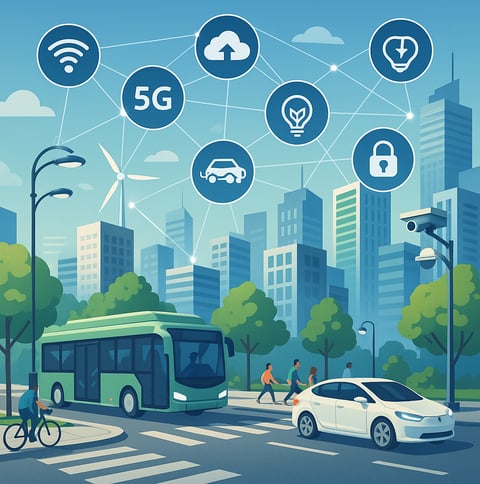Smart Cities: How Technology Will Change the Places We Live
Discover how smart cities are using technology to improve urban life with innovation, sustainability, and safety in smart cities!
Smart Cities: How Technology Will Change the Places We Live


Have You Ever Imagined Living in a City Where Traffic Flows Smoothly, the Streets Are Safer, and Even Trash Collection Is Smarter?
I get excited just thinking about it! That’s exactly what smart cities are bringing into our lives. They use technology to make the places we live more practical, sustainable, and enjoyable. Today, I’m going to explain what smart cities are and how they can change our daily lives — like we’re chatting on a bench in your town square. Let’s discover together how technology is transforming the places we call home!
What Are Smart Cities?
First, let me tell you what smart cities are. They’re places that use technology to solve everyday problems like traffic, pollution, and safety. For example, in a smart city, sensors on the streets can detect traffic jams, and traffic lights adjust automatically to help cars move better. Or cameras with artificial intelligence can spot something wrong — like an accident — and call for help right away. The goal is simple: use innovation to make urban life easier and better for everyone.
Here’s an interesting fact: according to the United Nations (UN), over 55% of the world’s population already lives in urban areas, and that number is expected to reach 68% by 2050. With so many people in cities, technology becomes a key ally in dealing with challenges like lack of space, pollution, and wasted resources. It’s like the city grows a smart brain to take care of everything!
How Is Technology Transforming Cities?
Now, let’s talk about how technology is changing the places we live. I’m amazed by the ideas already being used in cities around the world. Let me share some of the coolest ones to show just how powerful smart cities can be.
Smarter Traffic with Sensors and Data
Have you ever been stuck in traffic and thought, “Why doesn’t this get better?” In smart cities, that’s starting to change! They use sensors on the streets and data from apps to understand the flow of cars. For example, in Singapore, the Intelligent Transport System uses cameras and sensors to adjust traffic lights in real time. If a street is crowded, the green light stays on longer to ease the flow. This cuts down on time spent in traffic and reduces pollution, since cars use less fuel.
Here in Brazil, São Paulo is testing something similar. The city uses data from apps like Waze to monitor traffic and plan improvements. Isn’t it amazing how technology can solve things we thought were impossible?
Cleaner, More Sustainable Energy
Another thing smart cities do well is manage energy better. You know those streetlights that stay on all day, wasting electricity? In smart cities, they have sensors that turn on only when someone’s nearby or when it gets dark. In Barcelona, Spain, this system has already saved 30% of the energy used for public lighting, according to a city study.
Many smart cities are also investing in renewable energy, like solar panels on public buildings. In Copenhagen, Denmark, the goal is to be carbon neutral by 2025, and technology is helping make that happen. They use data to monitor energy use and find ways to reduce it. It’s like the city is learning to be greener through innovation!
Safer Streets with Artificial Intelligence
Security is another area that’s getting a major upgrade in smart cities. You’ve probably seen security cameras on the streets — but in smart cities, those cameras have artificial intelligence to “see” what’s happening. For example, in Chicago, USA, smart cameras can detect unusual situations — like a fight or accident — and alert the police immediately. This helps the city respond faster and keep people safe.
Here in Brazil, Rio de Janeiro is using a similar system. During Carnival, the city uses cameras and drones to monitor the crowds and prevent problems. I think that’s awesome — it really makes you feel safer when you’re out and about, right?
Sustainability: Greener, Cleaner Cities
Now let me tell you how smart cities are helping the environment. With so many people living in cities, waste and pollution are big problems. But technology is stepping in to help!
Smart Waste Management
In cities like Amsterdam, Netherlands, smart trash bins send alerts when they’re full, so garbage trucks only come when needed. This saves time, fuel, and keeps the streets cleaner. A city study showed this system reduced garbage truck trips by 20%. In Brazil, some cities like Florianópolis are testing smart bins with sensors to improve collection. It’s like the trash itself is saying, “Hey, I’m full, come pick me up!”
More Efficient Public Transport
Smart cities also help us get around in a more sustainable way. In London, for example, apps show where the next bus is in real time and whether it’s crowded. This makes people more likely to use public transport instead of cars, which reduces pollution. In Brazil, cities like Curitiba are investing in similar apps to help passengers. I’ve used one of these apps myself — it made planning my trip so much easier!
How Do Smart Cities Improve Our Lives?
Now think about it: how does all this change your day-to-day life? I get excited just imagining it! In a smart city, you spend less time in traffic because traffic lights are smarter. You breathe cleaner air because the city uses less energy and produces less pollution. And you feel safer because technology is watching out for you.
Smart cities are also built with people in mind. In Songdo, South Korea, the city was built from scratch to be a smart city. It has bike lanes everywhere, giant parks, and even a system that delivers groceries through underground tubes — to keep delivery trucks off the roads! A report by McKinsey says smart cities can improve residents' quality of life by up to 30%. That means more time to enjoy life and less stress from city problems.
The Challenges of Creating Smart Cities
But not everything is perfect, right? I don’t want to sugarcoat it — turning a city into a smart city has its challenges. First, it’s expensive. Installing sensors, cameras, and new systems costs a lot, and not every city has the budget. In Brazil, for example, many cities are still dealing with basic issues like sanitation, so investing in tech can be tough.
Another issue is privacy. With so many cameras and sensors collecting data, some people worry: “Are they watching me?” That’s a valid concern! That’s why smart cities need clear rules to protect people’s data. In Amsterdam, for example, they created a “data contract” that explains exactly how information is used — so no one has to worry.
What Does the Future Hold for Smart Cities?
Looking ahead, I see a bright future for smart cities. Experts say that as technology advances, cities will become even smarter. For example, self-driving cars will connect with city systems to avoid accidents and traffic jams. A Deloitte study predicts that by 2030, 70% of large cities will have some kind of smart technology.
In Brazil, we’re starting slowly, but there are already some great projects. In Recife, the city uses sensors to monitor flooding and warn residents ahead of time. It’s a small step, but it already makes a big difference for those who live there. I’m rooting for more cities here to join this smart wave!
How Can This Change Your Life?
Now think about how all this could impact your life. Imagine living in a city where you don’t waste hours in traffic, where the air is cleaner, and where you feel safer walking at night. Smart cities aren’t just about technology — they’re about better living. You’ll have more time to spend with your family, relax in the park, or simply enjoy life, because the city is working for you.
Of course, it doesn’t happen overnight. But little by little, technology is transforming the places we live — and I’m excited to see it happening. What about you?
The Future of Cities Is Coming
So, what did you think of our chat? Smart cities are using technology to change the way we live, bringing more convenience, sustainability, and safety. With sensors, AI, and innovative ideas, they’re solving problems like traffic, pollution, and security — and making life more enjoyable. Sure, there are still challenges like cost and privacy, but the future looks promising.
If you liked learning more, why not keep an eye on your city’s projects? Maybe it’s already taking the first steps to becoming a smart city! The important thing is knowing that technology is here to help us live better — and that’s pretty great news!
Fontes
Organização das Nações Unidas (ONU). “World Urbanization Prospects 2018.” Disponível em: https://www.un.org/development/desa/en/news/population/2018-revision-of-world-urbanization-prospects.html
McKinsey Global Institute. “Smart Cities: Digital Solutions for a More Livable Future.” 2018. Disponível em: https://www.mckinsey.com/business-functions/operations/our-insights/smart-cities-digital-solutions-for-a-more-livable-future
Deloitte Insights. “The Future of Smart Cities.” 2020. Disponível em: https://www2.deloitte.com/us/en/insights/industry/public-sector/future-of-smart-cities.html
Cidade de Barcelona. “Barcelona Smart City Projects.” Disponível em: https://www.barcelona.cat/en/smart-city
Cidade de Amsterdã. “Amsterdam Smart City Initiatives.” Disponível em: https://amsterdamsmartcity.com/
